Palazzo Altemps, a sixteenth-century palace situated in Campo Marzio, an area just north of Piazza Navona, is home to a branch of the Museo Nazionale Romano (National Roman Museum).

Since 1997 the museum has been displaying an exquisite collection of ancient Roman statues here, without a doubt one of the best in Rome. The building itself, with a beautiful loggia and painted walls, is a sight in itself.

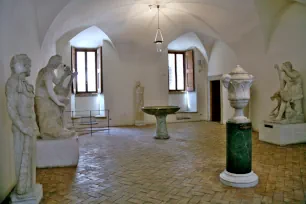
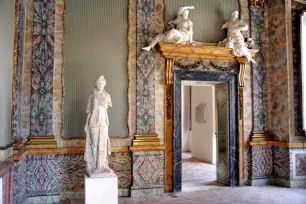
The Palace
The palace was built around 1477-1480 for Girolamo Riario, nephew of Pope Sixtus IV. In 1488 Riario was assassinated, and his palace was looted. In 1520 the palace was bought by Volterra Francesco Soderini, who had the building expanded.
In 1568 the palace was acquired by Markus Sittikus von Hohenems, a cardinal from German descent whose name was Italianized to Marco Sittico Altemps.
Altemps commissioned a thorough renovation of the palace, the result of which we can see today. The church of Anicetus, the beautiful courtyard and the loggia all date from this period. Most of the renovation was the work of Martino Longhi the Elder, who also added the elegant rooftop terrace, topped with obelisks and a statue of an ibex – symbol of the Altemps.
The palace stayed in the hands of the Altemps family until 1894 when it was ceded to the papacy, who used it as a seminary. In 1982 the building, which stood empty and had fallen into disrepair, was acquired by the Italian state. The palace was restored and opened in 1997 as a branch of the National Roman Museum.
The Museum
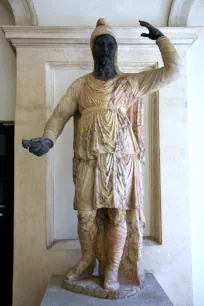
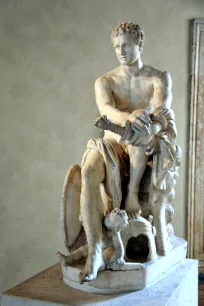
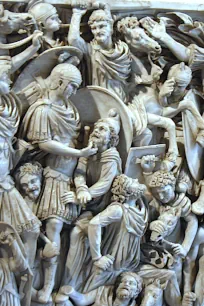
A visit to the museum starts in the courtyard, from where you can access the rooms on the ground floor or take the stairs up to the first floor, where you’ll find most of the museum’s star attractions. Information cards in English and Italian provide plenty of detail and background information on all the important statues.
The Collections
Marco Sittico Altemps was an avid collector, and he assembled a valuable collection of books and ancient statues. His nephew Giovanni Angelo Altemps continued to add to the collection. Most of the Altemps collection, however, which consisted of over one hundred sculptures, paintings and books, is now spread over a number of different institutions. Some of the statues of the Altemps collection are still in the palace today, including the large statues that grace the northern loggia.
The core of the museum’s holdings comprises over one hundred statues from the collection of the seventeenth-century cardinal Ludovico Ludovisi. For the most part of the twentieth century, this important collection was on display at the Baths of Diocletian until it found its new home in Palazzo Altemps. Most of the museum’s top artworks come from this collection.

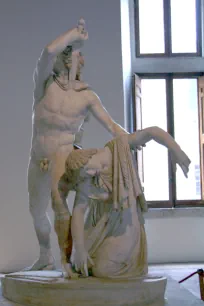
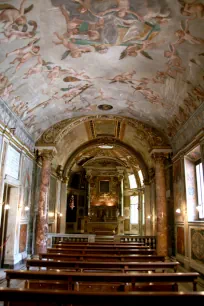
The museum also has works from three smaller collections: The Mattei Collection – with ancient Roman sculptures once owned by art collector Ciriaco Mattei; the Drago Collection – four reliefs from the del Drago family; and the Egyptian collection, which contains authentic Egyptian statues that stood in the area of Campus Martius during the Antiquity and Roman statues that were created in Egyptian style – a style that was very fashionable in Rome during the decades following the conquest of Egypt.
Highlights
One of the first important works you’ll see on the ground floor is a statue of Emperor Antonius Pius. Further on, you can see a statue of the goddess Athena and a sculpture group depicting Dionysus with a satyr and panther. There’s also a unique statue of a Dacian, in yellow marble. It is the most famous of the statues that once adorned the Villa of Ciriaco Mattei.
The first floor, the so-called noble floor, is where the nobility lived – the ground floor was used to receive guests and house servants. The rooms here give a good impression of what a sixteenth-century palazzo looked like from the inside. There are still remains visible of beautiful wall frescoes, and the ceilings are often painted or even gilded.
There are numerous noteworthy statues here. One of the most famous is the Ludovisi Throne, which shows the birth of Venus. It was probably made in the fifth century BC in Greece. Another must-see is the Ludovisi Ares, a marble statue of the god of war: Mars. Nearby is a huge head of Hera.
The Salone del Camino (Fireplace Salon), named for its monumental marble fireplace mantel, is home to the grand Ludovisi Battle Sarcophagus, decorated with a finely carved relief depicting battle scenes. In the middle of the room stands another famous statue: the so-called Galatian Suicide, which depicts a Gaul who commits suicide after having killed his wife. Rooms nearby show more peaceful statues, including one of Pan and Daphnis and one with the amorous couple Cupid and Psyche.
The palace has its own church, the Sant’Aniceto nel Palazzo Altemps. The Baroque church features a lovely ceiling, painted with dancing cherubs. The church contains the tomb of Saint Anicetus, pope from 157 until his death in 168 AD.
Finally, don’t miss the north loggia, with its painted pergola and its row of busts of Roman emperors.
- Next: Palazzo Massimo
- More Sights & Attractions in Rome

